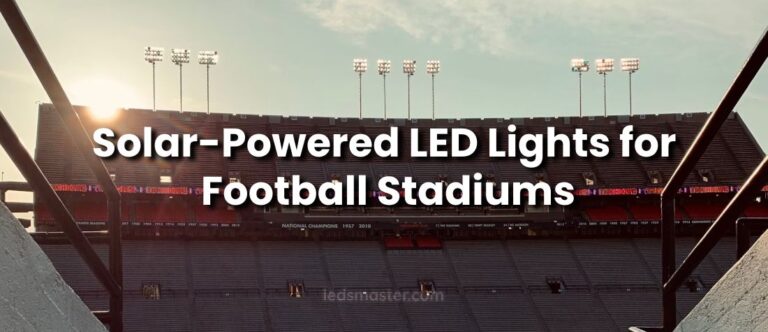
Experience the future of sustainable sports with our advanced solar stadium lighting solutions. Harnessing solar power, our systems efficiently illuminate stadiums, ensuring visibility and safety while reducing carbon footprints and costs. Join us in revolutionizing stadium lighting with renewable energy and explore how solar innovation is reshaping sports venues sustainably.
Get your complimentary lighting design today
Step into a new era of sports lighting with our innovative solar stadium solutions. Designed to combine cutting-edge technology with environmental stewardship, our systems harness solar energy to illuminate stadiums efficiently and sustainably. By reducing carbon footprints and operational costs while ensuring optimal visibility and safety, we redefine stadium lighting for the modern age.
Table of Contents
ToggleIn today’s world, the urgency for sustainable solutions in various industries is more pronounced than ever. As the effects of climate change become increasingly evident, there is a growing consensus on the need to adopt eco-friendly technologies. Within this landscape, solar stadium lighting has emerged as a beacon of innovation, merging sustainability with the sporting world. Sporting events attract millions of viewers globally, leading to significant energy demands for stadium lighting. Traditional systems, which rely heavily on grid electricity, pose environmental and financial challenges that are hard to ignore. Solar stadium lighting provides a promising alternative that addresses these challenges while setting new standards for sustainability in sports infrastructure.

Solar stadium lighting systems harness the sun’s energy through photovoltaic (PV) panels installed on or near stadium premises. These panels convert sunlight into electricity, which is either stored in batteries for later use or fed directly into the stadium’s electrical grid. This sustainable approach allows for the powering of high-intensity discharge (HID) lamps or energy-efficient light-emitting diode (LED) fixtures. These lighting solutions ensure adequate illumination for events ranging from local games to international tournaments.
The fundamental mechanism of solar energy lies in the use of PV cells, which are made from semiconductor materials that absorb sunlight and release electrons, generating electricity. This process is known as the photovoltaic effect. By incorporating these technologies into stadiums, venues can tap into a renewable energy source that is both abundant and sustainable.
Implementing solar stadium lighting does not necessitate a complete overhaul of existing infrastructure. Stadium operators can retrofit their facilities with solar technologies, making use of available roof space or adjacent areas. This versatility ensures that stadiums can transition to solar energy without sacrificing their operational capabilities or aesthetic appeal.
One of the advantages of solar stadium lighting systems is their efficiency. By converting sunlight directly into electricity, these systems bypass the inefficiencies associated with traditional fossil fuel-based power generation. Furthermore, advancements in PV technology have significantly improved energy conversion rates and system reliability, making solar energy increasingly viable for large-scale applications, including stadium lighting.
The latest developments in solar technology have led to more efficient and durable PV panels that can generate more power even in less-than-ideal conditions. High-efficiency panels can capture and convert a larger percentage of sunlight into electricity, while improvements in battery technology allow for better energy storage solutions. This means that solar lighting systems can effectively illuminate stadiums during evening events or cloudy weather, ensuring a reliable power supply.
Modern solar lighting systems are designed to meet the demanding requirements of stadium environments. LED fixtures are known for their energy efficiency and long lifespan, providing bright and uniform illumination across both the playing field and spectator areas. This not only ensures optimal visibility for athletes and spectators but also contributes to reducing light pollution and glare, enhancing the overall experience for everyone involved.
The environmental implications of adopting solar stadium lighting are profound. Transitioning to solar energy can substantially reduce carbon footprints, as these systems decrease reliance on grid electricity derived from fossil fuels. By mitigating greenhouse gas emissions, solar lighting aligns with global efforts to combat climate change and fosters a more sustainable approach to sports venue operations.
Moreover, solar stadium lighting contributes to environmental sustainability in various ways beyond mere emissions reduction. The installation of PV panels often utilizes underutilized or previously overlooked spaces within stadiums or their surrounding areas. This dual-purpose approach maximizes land use efficiency and enhances the visual appeal of sports facilities, which can serve as prominent examples of renewable energy integration.
Additionally, solar stadium lighting can have a positive impact on local ecosystems. By reducing dependence on grid electricity, stadiums can help lessen the overall demand for power generation, leading to less strain on natural resources. This shift not only supports environmental conservation efforts but also promotes biodiversity in surrounding areas, as reduced light pollution can benefit local wildlife.
While the initial costs of implementing solar stadium lighting systems may seem daunting, the long-term economic advantages are compelling. These systems can lead to substantial savings on operational expenses, such as electricity bills and maintenance costs. Over time, solar installations prove to be financially beneficial, making them a worthy investment for stadium operators.
The reliance on renewable energy sources provides stadium operators with a buffer against the volatility of fossil fuel pricing, allowing for greater stability and predictability in energy expenditures. As energy prices continue to fluctuate, solar stadium lighting can offer a consistent and predictable cost structure.
Governments and utility companies worldwide are increasingly offering incentives and rebates to encourage the adoption of renewable energy technologies. These financial incentives can help offset initial investment costs, making solar stadium lighting more accessible and appealing to owners and operators. By capitalizing on these opportunities, stadiums can significantly reduce their upfront costs and enhance their financial viability.
The economic benefits of solar stadium lighting extend beyond direct cost savings. By adopting solar energy solutions, sports venues can increase their overall value and appeal. Solar installations signal a commitment to environmental stewardship, resonating positively with fans, sponsors, and the broader community.
In an era where sustainability is becoming a core value for many consumers, stadiums that prioritize eco-friendly practices can attract eco-conscious fans and sponsors. This alignment with consumer values can enhance brand loyalty and create opportunities for new partnerships, as sponsors increasingly seek to associate their brands with sustainable practices.
Moreover, the adoption of solar stadium lighting can strengthen the relationship between sports venues and their local communities. By demonstrating a commitment to sustainability, stadiums can foster goodwill and engagement among residents. Community programs, such as educational initiatives focused on renewable energy, can further enhance this connection, positioning stadiums as leaders in sustainable practices.
Despite the numerous advantages of solar stadium lighting, several challenges must be navigated for successful implementation. Understanding these obstacles is crucial for stadium operators looking to transition to solar energy.
One of the challenges associated with solar energy is variability in sunlight availability due to weather conditions. Cloud cover, rainy days, and geographical differences can all impact energy generation. As a result, effective energy storage solutions, such as advanced battery technologies, are necessary to ensure reliable operation during periods of low or no sunlight.
While solar technology has advanced, there are still limitations regarding energy storage capacity and efficiency. Stadium operators must carefully assess their energy needs and determine the appropriate scale for their solar installations. Ensuring that energy generation meets peak demand times is critical for maintaining optimal performance.
Another challenge is the physical space required for installing PV panels. In urban areas, where stadiums may be located in densely populated settings, finding adequate space for solar panels can be complex. However, creative solutions such as utilizing rooftops, parking lots, or other underutilized areas can help maximize energy generation potential while minimizing visual impact. Careful planning and integration of solar technology into stadium design are essential to overcome these constraints.
To successfully implement solar stadium lighting, a thoughtful design and engineering approach is required. Stadium operators must collaborate with architects and engineers to ensure that solar panels are effectively incorporated into the venue’s overall design.
When incorporating solar technology into stadium design, aesthetic considerations should not be overlooked. Solar panels can be integrated into architectural elements, creating visually appealing features that enhance the stadium’s overall appearance. For instance, solar canopies over walkways or shaded areas can serve dual purposes—providing shelter for fans while generating clean energy.
Furthermore, innovative architectural solutions can enhance the performance of solar installations. For instance, orienting solar panels to capture optimal sunlight or utilizing building-integrated photovoltaics (BIPV) can maximize energy generation potential. By embedding solar technology into the building’s design, stadiums can enhance their sustainability efforts without compromising functionality.

Government policies are instrumental in promoting the adoption of solar stadium lighting. As sustainability becomes a central theme in public policy, governments worldwide are enacting legislation and providing incentives to encourage renewable energy initiatives.
In many regions, local and national governments offer financial incentives for renewable energy projects. These incentives can come in the form of grants, tax credits, or low-interest loans that help offset the initial costs of solar installation. By reducing the financial burden, governments facilitate the transition to renewable energy, making it easier for sports venues to adopt solar stadium lighting.
In addition to direct incentives, governments often collaborate with utility companies to promote renewable energy initiatives. These partnerships can lead to programs that allow stadiums to sell excess energy back to the grid, further enhancing the economic viability of solar lighting systems. By providing a financial return on investment, these programs can make solar stadium lighting more attractive to facility owners.
Effective regulatory frameworks promote solar stadium lighting. By establishing clear guidelines for solar energy generation and integration into existing infrastructures, governments can streamline the permitting process and reduce bureaucratic hurdles. This can encourage more sports venues to consider solar solutions, as the path to implementation becomes clearer and more straightforward.
The adoption of solar stadium lighting goes beyond the operational benefits; it also offers opportunities for community engagement and education. Sports venues can leverage their influence to promote awareness of renewable energy and sustainability practices.
Stadiums that implement solar technologies can develop educational programs aimed at teaching fans and community members about the importance of renewable energy. Workshops, guided tours, and informational sessions can provide valuable insights into solar energy systems, promoting greater awareness and understanding of sustainable practices.
The impact of solar stadium lighting extends beyond immediate benefits to sports venues. By adopting renewable energy solutions, sports facilities can influence broader societal attitudes toward sustainability and renewable energy.
As prominent community institutions, sports venues have the potential to shape public perception of renewable energy. When fans and visitors see solar-powered stadiums in action, they are more likely to recognize the viability and importance of solar technology in everyday life. This increased awareness can lead to greater acceptance of renewable energy solutions in other sectors, encouraging individuals and organizations to explore similar initiatives.
Moreover, the adoption of solar lighting systems can inspire other sports organizations to prioritize sustainability in their operations. When successful examples of solar-powered stadiums are showcased, they can serve as models for other facilities looking to improve their environmental performance. This collective movement towards sustainability within the sports industry can lead to a more significant shift towards renewable energy solutions across various sectors.
By committing to solar stadium lighting, sports venues can establish a legacy of sustainability that resonates with fans, sponsors, and communities. This legacy can foster a culture of environmental responsibility and inspire future generations to prioritize sustainable practices in sports and beyond. As the sports industry continues to evolve, solar energy solutions will play an increasingly integral role in shaping a greener and more sustainable future.
Solar stadium lighting stands at the forefront of sustainable innovation, offering a compelling alternative to traditional grid-dependent systems. By harnessing solar energy, these solutions not only address environmental concerns and reduce carbon footprints but also enhance operational efficiency and cost-effectiveness over time. Despite challenges like weather variability and space constraints, ongoing advancements in technology continue to bolster the viability and scalability of solar installations in sports venues worldwide.